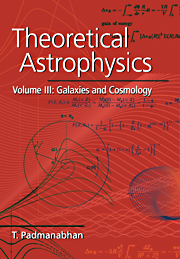Book contents
- Frontmatter
- Contents
- Preface
- 1 Overview: Galaxies and Cosmology
- 2 Galactic Structure and Dynamics
- 3 Friedmann Model of the Universe
- 4 Thermal History of the Universe
- 5 Structure Formation
- 6 Cosmic Microwave Background Radiation
- 7 Formation of Baryonic Structures
- 8 Active Galactic Nuclei
- 9 Intergalactic Medium and Absorption Systems
- 10 Cosmological Observations
- Notes and References
- Index
3 - Friedmann Model of the Universe
Published online by Cambridge University Press: 05 June 2012
- Frontmatter
- Contents
- Preface
- 1 Overview: Galaxies and Cosmology
- 2 Galactic Structure and Dynamics
- 3 Friedmann Model of the Universe
- 4 Thermal History of the Universe
- 5 Structure Formation
- 6 Cosmic Microwave Background Radiation
- 7 Formation of Baryonic Structures
- 8 Active Galactic Nuclei
- 9 Intergalactic Medium and Absorption Systems
- 10 Cosmological Observations
- Notes and References
- Index
Summary
Introduction
This chapter deals with the Friedmann model for the universe, which is used throughout the study of extragalactic astronomy. The basic framework needed in all the later chapters is also introduced. Some of the discussion requires concepts from the general theory of relativity developed in Vol. I, Chap. 11. The Latin indices go over i, j = 0, 1, 2, 3, and the Greek indices go over α, β = 1, 2, 3. We shall use units with c = 1 in most sections.
The Friedmann Model
To construct the simplest model of the universe, we begin by assuming that the geometrical properties of three-dimensional space are the same at all spatial locations and that these geometrical properties do not single out any special direction in space. Such a three-dimensional space is called homogeneous and isotropic.
The geometrical properties of the space are determined by the distribution of matter through Einstein's equations. It follows therefore that the matter distribution should also be homogeneous and isotropic. This is certainly not true in the observed universe, in which there exists a significant degree of inhomogeneity in the form of galaxies, clusters, etc. We assume that these inhomogeneities can be ignored and the matter distribution may be described by a smoothed-out average density in studying the large-scale dynamics of the universe.
- Type
- Chapter
- Information
- Theoretical Astrophysics , pp. 161 - 209Publisher: Cambridge University PressPrint publication year: 2002



